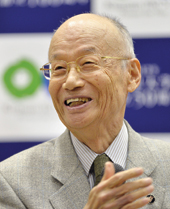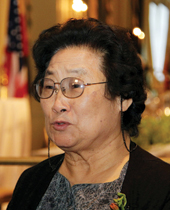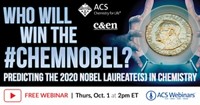Advertisement
Grab your lab coat. Let's get started
Welcome!
Welcome!
Create an account below to get 6 C&EN articles per month, receive newsletters and more - all free.
It seems this is your first time logging in online. Please enter the following information to continue.
As an ACS member you automatically get access to this site. All we need is few more details to create your reading experience.
Not you? Sign in with a different account.
Not you? Sign in with a different account.
ERROR 1
ERROR 1
ERROR 2
ERROR 2
ERROR 2
ERROR 2
ERROR 2
Password and Confirm password must match.
If you have an ACS member number, please enter it here so we can link this account to your membership. (optional)
ERROR 2
ACS values your privacy. By submitting your information, you are gaining access to C&EN and subscribing to our weekly newsletter. We use the information you provide to make your reading experience better, and we will never sell your data to third party members.
Neuroscience
William C. Campbell, Satoshi Ōmura and Youyou Tu Win 2015 Nobel Prize for Physiology or Medicine
Awards: Researchers' work led to drugs against roundworm diseases and malaria
by Sarah Everts
October 5, 2015

Three octogenarians who developed cures for malaria and roundworm diseases have won this year’s Nobel Prize for Physiology or Medicine.
William C. Campbell of Drew University and Satoshi Ōmura of Japan’s Kitasato University will share half the prize for developing ivermectin and avermectin. These drugs cure diseases caused by parasitic roundworms, including river blindness and elephantiasis. “I humbly accept it,” Ōmura said to a member of the Nobel Prize Organization. The Japanese scientist confirmed that the avermectin family of natural products emerged from soil samples containing Streptomyces bacteria that he had collected near a golf course. His cowinner Campbell, who was then working at Merck, led the medicinal chemistry campaign that turned avermectin into ivermectin (J. Med. Chem., 1980, DOI: 10.1021/jm00184a014).



The other half of this year’s Nobel Prize in Physiology or Medicine goes to Youyou Tu of China’s Academy of Traditional Chinese Medicine for her work to discover artemisinin, a drug against malaria.
Artemisinin was developed as part of a secret research initiative called “523,” launched by Mao Tse-tung in 1967 during the height of the Vietnam War. The initiative was launched as many Chinese soldiers fighting for communist North Vietnam were dying of malaria because the existing drug, chloroquine, was no longer effective (Cell, 2011, DOI: 10.1016/j.cell.2011.08.024).
More than 50 laboratories and 500 scientists were involved in the secret project that eventually led to artemisinin. To find inspiration for the drug, Tu looked in many ancient Chinese medicinal texts and assembled some 2,000 possible recipes that claimed to cure the fever symptoms common in malaria patients.
The team found what they were looking for in a manuscript from A.D. 340 called the “Handbook of Prescriptions for Emergencies.” The recipe required scientists to perform an extraction from of a common Chinese plant called sweet wormwood. But at first the extract did not seem curative. That’s because the researchers had been destroying the active ingredient by boiling the wormwood leaves. Tu went back to the original text and read that the extraction was supposed to be done in cold water. When her team tried doing the extractions with ether, they found a chemical in the extract that was active against malaria: artemisinin. Its derivatives are still used today to fight malaria.
The discovery of artemisinin has had “unbelievable impact,” says Peter Seeberger, a malaria researcher and director at Max-Planck-Institute of Colloids and Interfaces. “To say that millions of lives have been saved is an understatement.” Some 350 million doses of artemisinin-derived drugs are given every year, he says.
“The discoveries by William C. Campbell and Satoshi Ōmura have provided revolutionary therapies against elephantiasis and river blindness,” said Hans Forssberg, a member of the committee that selected the prize. “Parasitic diseases have plagued humankind throughout our existence. And still today they affect hundreds of millions of the most vulnerable citizens of the world,” Forssberg said. “The global impact of their discovery and the resulting benefit to mankind is immeasurable.”
Related Stories:
Ivermectin: C&EN’s Top Pharmaceuticals That Changed the World
Letter from Ōmura
What Type of Research Wins the Nobel Prize?
Ancient Recipes Carried Out in Modern-day Laboratories







Join the conversation
Contact the reporter
Submit a Letter to the Editor for publication
Engage with us on Twitter